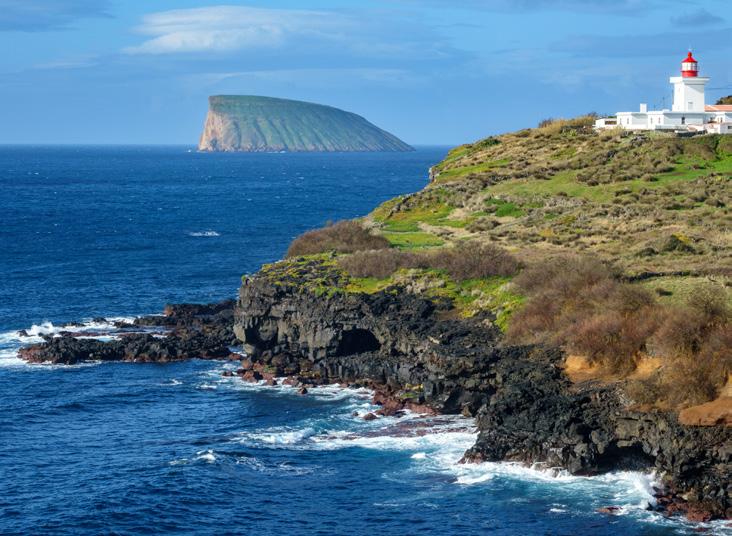
8 minute read
Your cruise highlights
This symbol indicates excursions that include a visit to UNESCO World Heritage Sites. Do not miss!
CANARY ISLANDS Island of contrasts
Advertisement
The second smallest Canary Island, La Gomera, is green and fertile due to the trade winds in the north and is perfect for hiking. The Garajonay National Park in particular is a popular excursion destination and was declared a UNESCO World Heritage Site. A circular walk takes you though the mystical cloud forest to beautiful vantage points and the tiny mountain village of Las Hayas. From Vallehermoso, you will get a fantastic panoramic view of the hilly green countryside and the sea behind it. In the south, sun worshippers really get their money‘s worth; with a mostly cloudless sky and sandy beaches, it is the perfect spot for a bit of relaxation. San Sebastián is the capital city of the small island with large plazas, where locals meet to exchange news and where children play. Christopher Columbus was said to have once replenished his water supplies at the fountain of the former customs house. Route T2 • T3 • T4 • T5
Mountain world meets sandy beaches
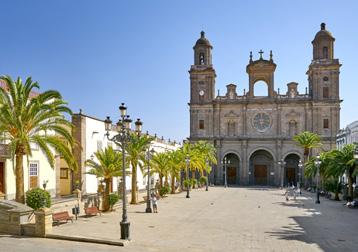
Maspalomas in the south of Gran Canaria will surprise you with its sweeping sand dunes which are six kilometres long and up to two kilometres wide: an intact nature reserve, surrounded by a diverse mountain world. Just a stone’s throw away from the bustling capital city of Las Palmas is Bandama Natural Park. Stroll through the vineyards of Tafira up to the crater of the Caldera de Bandama. The cone can be seen from quite a distance and offers a wonderful panoramic view from its peak. The island’s capital city is not just perfect for a stroll through the old town, it also has a sandy beach “Las Canteras” stretching for several miles across the whole bay. Route T2 • T4 • T5
SPAIN Andalusian flair
Cádiz in Andalusia is an old Spanish harbour city. Built on a headland, it is surrounded almost on all sides by the sea. More than 100 watch towers were traditionally used to look out for merchant and expedition ships. From Cádiz, you can visit Seville, Andalusia’s capital city. The gothic cathedral there is where you will find Christopher Columbus’ tomb. A stone’s throw away from Cádiz is Jerez de la Frontera, well known for its royal Andalusian riding school and sherry production. Route T5

La Gomera, San Sebastián
Las Palmas, Cathedral Santa Ana
Corvo Lajes das Flores
Horta Praia/ Baía da Folga
Praia da Vitória
Lajes Do Pico
THE AZORES Ponta Delgada Vila Do Porto
Route T1 Madeira-Azores-Madeira Route T2 Madeira-Casablanca-Gran Canaria-La Gomera-Tenerife Route T3 Tenerife-Madeira-Lanzarote-La Gomera-Tenerife Route T4 Tenerife-Safi-Madeira-La Gomera-Tenerife Route T5 Tenerife-Las Palmas-Casablanca-Cádiz-Lisbon Route T6 Lisbon-Azores-Madeira
PORTUGAL Lisbon
Portimão
SPAIN Cádiz Tangier
ATLANTIC OCEAN MADEIRA Funchal Porto Santo
Casablanca
Safi MOROCCO
Santa Cruz de Tenerife
Santa Cruz de La Palma CANARY ISLANDS San Sebastián de La Gomera Arrecife Puerto del Rosario Las Palmas de Gran Canaria
Black volcanic rock & cacti
Timanfaya National Park on the island of Lanzarote offers a unique experience of nature. You will see huge lava fields and look into deep lava valleys, from which volcanic cones protrude. This lava landscape is unique in Europe. You will feel the rising heat from the earth as you journey through the fields and valleys up to the edge of open volcanic craters. The wonderful cacti garden of the artist César Manrique is laid out like an amphitheatre. On around 5,000 square metres, you will find 1,400 different types of cacti. The green plants, the blue sky and the black volcano stone provide a unique colour contrast. A place where art, architecture and nature come together in perfect harmony. Route T2 • T3 • T4 • T5
La Palma, the fifth largest of the Canary Islands, will impress you with its rustic rocks, laurel forests, roaring waterfalls and fantastic volcanoes, such as the Teneguía and the volcano ridge Cumbre Vieja. Go on a hike through the Caldera de Taburiente National Park along the edge of the crater and enjoy the view of the neighbouring islands. The green island is just 417 kilometres away from the Moroccan coast and the climate is mild all year round. The island capital city of Santa Cruz de la Palma on the east coast invites you to take a stroll through its narrow lanes past the historic colonial houses. Cafés and restaurants offer homemade tapas and wine. The locals also call the island “La Isla Bonita” – the beautiful island. Route T5
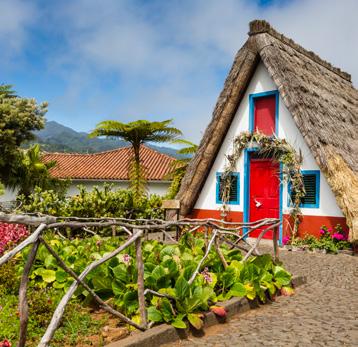
PORTUGAL The Flower Island in the Atlantic
Madeira will surprise you with its diverse and breath-taking countryside. Picturesque fishing villages, fantastic views of the steep coasts over bizarre rock formations and roaring waterfalls set the scene. The island’s capital city of Funchal offers sights including the Sé Cathedral and the market hall, where you can buy everything from exotic fruits to colourful flowers and fresh fish. In the Jardim Botânico, the botanical gardens, you will not only find a multiplicity of exotic plants, you will also be able to enjoy a beautiful view across the island. Route T1 • T2 • T3 • T4 • T6
The small neighbouring island of Porto Santo is quieter. Eiland, called the “Ilha Dourada” (golden island) by the locals due to its bright yellow stone, was once home to Christopher Columbus. Today, it’s a real insider’s tip, particularly for swimmers and nature lovers.
Marrakesh, Menara Garden
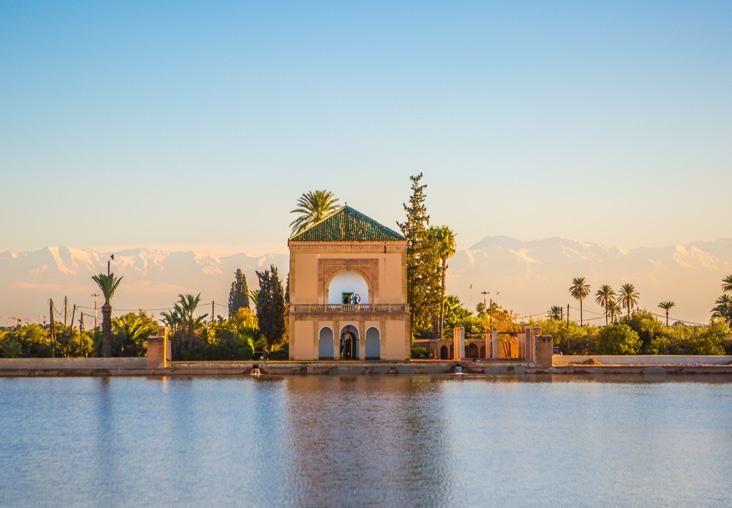
MOROCCO Moorish style meets art deco
The word Casablanca means “The White House”, but it has become a white city. This harbour city is the largest in Morocco with more than three million inhabitants. Founded in the 8th century, this settlement has always been disputed. Portuguese, Spaniards and French joined its inhabitants. The cityscape is dominated by the great Hassan II mosque with space for 25,000 faithful worshippers and a minaret of 210 metres in height, the tallest of its kind in the Islamic world. The city is also home to Moroccan Jews, who run over 300 synagogues. The bustling Boulevard de la Corniche snakes along the coast. Rabat, its neighbour on the Atlantic coast, is the seat of the government and the King’s residence. Rabat has been a UNESCO World Heritage Site since 2012. Route T2 • T4 • T5
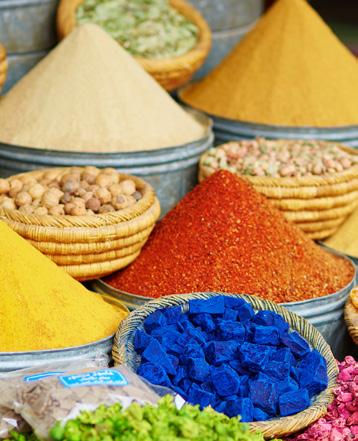
Oriental magic
From the harbour city of Safi, the route leads you to Marrakesh. Here, you will find mosques, labyrinthine streets through the medina, magical palaces, secret gardens and bustling souks. The medina sells traditional clothing, pottery, woodcarvings and jewellery. On the central square Djema el Fna, donkey carts and mopeds make their way between food stalls. Artists, fortune tellers and snake charmers hope to arouse your curiosity. It evokes oriental magic like something out of a fairy tale. In addition, the UNESCO city also has its elegant side with mosaics, decorated wooden portals and spring fountains in quiet inner courtyards. Route T2 • T4 • T5
Colourful offerings at a souk
For more information, see: www.nicko-cruises.info/canaries
Tangier is situated in the far northwest of Morocco on the Straits of Gibraltar. The city has always been a crucible of different cultures. The Anglican church of St. Andrew was built in Moorish style and the city itself boasts a surprising number of European and Mediterranean building styles. The Cave of Hercules is worth seeing: according to legend, Hercules sought refuge in this cave; in fact it was inhabited in the sixth millennium before Christ.
The nearby city of Tétouan is the summer residence of the Moroccan king Mohammed VI. Its completely white Medina with winding lanes and traditional architecture has been named a UNESCO World Heritage Site. Route T5
THE AZORES The Islands of the Hawks
Situated almost halfway to the American mainland are the Azores. First discovered in the early 15th century by Portuguese seafarers, these islands belong to Portugal. They named the archipelago “Ilhas dos Açores”, Islands of the Hawks. It later transpired that they are actually buzzards living on the Azores. Nevertheless, the name stuck. The Azores are a paradise for nature lovers. As well as the numerous hydrangeas that have found the ideal habitat on the volcanic soil, you will find numerous endemic plants and animals here. With a little luck, you will see the Azores noctule or Monteiro’s storm petrels. Route T1 • T6
European seafaring history
On Terceira you will experience an exciting blend of volcanic landscapes, fantastic bathing bays and little Portuguese towns. The colourful capital of the island, Angra do Heroísmo, was listed as a UNESCO World Heritage Site due to its extraordinary role in maritime trade between the Old and the New World. Route T6
Culinary highlights
São Miguel is the largest of the nine Azores and its special climate even allows for the cultivation of tea in Europe’s only plantation. On the island, formed from volcanos, you can admire waterfalls und crater lakes. A special feature of the local cuisine is the preparation of dishes on the hot volcanic steam, like the exquisite Cozido, a traditional stew. Route T1 • T6
A paradise for whales
The island of Pico is dominated by the over 2,300-metrehigh volcano Ponta do Pico. The volcano, which is still active, is also Portugal’s highest mountain. It formed the island over 250,000 years ago, blessing it with fertile volcanic soil, on which excellent wine is grown. The island’s viticulture was listed as a UNESCO World Heritage Site in 2004. The coasts of Pico are world-famous for whale watching. Here, dolphins, pilot whales and even sperm whales cavort around, welcoming visitors. Route T1 • T6
